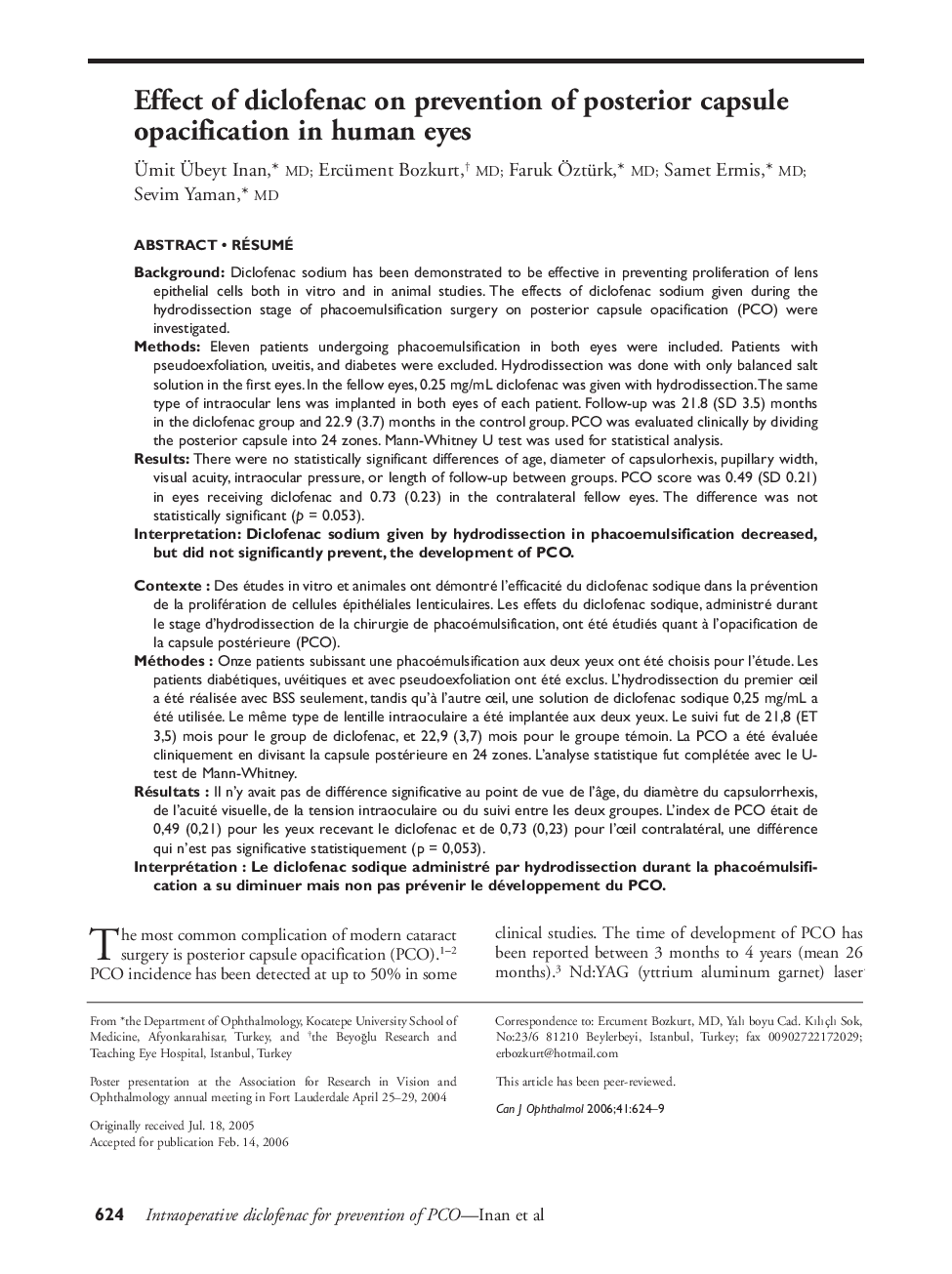| کد مقاله | کد نشریه | سال انتشار | مقاله انگلیسی | نسخه تمام متن |
|---|---|---|---|---|
| 4011052 | 1602454 | 2006 | 6 صفحه PDF | دانلود رایگان |

Background: Diclofenac sodium has been demonstrated to be effective in preventing proliferation of lens epithelial cells both in vitro and in animal studies. The effects of diclofenac sodium given during the hydrodissection stage of phacoemulsification surgery on posterior capsule opacification (PCO) were investigated.Methods: Eleven patients undergoing phacoemulsification in both eyes were included. Patients with pseudoexfoliation, uveitis, and diabetes were excluded. Hydrodissection was done with only balanced salt solution in the first eyes. In the fellow eyes, 0.25 mg/mL diclofenac was given with hydrodissection.The same type of intraocular lens was implanted in both eyes of each patient. Follow-up was 21.8 (SD 3.5) months in the diclofenac group and 22.9 (3.7) months in the control group. PCO was evaluated clinically by dividing the posterior capsule into 24 zones. Mann-Whitney U test was used for statistical analysis.Results: There were no statistically significant differences of age, diameter of capsulorhexis, pupillary width, visual acuity, intraocular pressure, or length of follow-up between groups. PCO score was 0.49 (SD 0.21) in eyes receiving diclofenac and 0.73 (0.23) in the contralateral fellow eyes. The difference was not statistically significant (p = 0.053).Interpretation: Diclofenac sodium given by hydrodissection in phacoemulsification decreased, but did not significantly prevent, the development of PCO.
RésuméContexte: Des études in vitro et animales ont démontré l’efficacité du diclofenac sodique dans la prévention de la prolifération de cellules épithéliales lenticulaires. Les effets du diclofenac sodique, administré durant le stage d’hydrodissection de la chirurgie de phacoémulsification, ont été étudiés quant à opacification de la capsule postérieure (PCO).Méthodes: Onze patients subissant une phacoémulsification aux deux yeux ont été choisis pour l’étude. Les patients diabétiques, uvéitiques et avec pseudoexfoliation ont été exclus. l’hydrodissection du premier œil a été réalisée avec BSS seulement, tandis qu’à l’autre œil, une solution de diclofenac sodique 0,25 mg/mL a été utilisée. Le même type de lentille intraoculaire a été implantée aux deux yeux. Le suivi fut de 21,8 (ET 3,5) mois pour le group de diclofenac, et 22,9 (3,7) mois pour le groupe témoin. La PCO a été évaluée cliniquement en divisant la capsule postérieure en 24 zones. l’analyse statistique fut complétée avec le U-test de Mann-Whitney.Résultats: Il n’y avait pas de différence significative au point de vue de l’âge, du diamètre du capsulorrhexis, de l’acuité visuelle, de la tension intraoculaire ou du suivi entre les deux groupes. l’index de PCO était de 0,49 (0,21) pour les yeux recevant le diclofenac et de 0,73 (0,23) pour l’œil contralatéral, une différence qui n’est pas significative statistiquement (p = 0,053).Interprétation: Le diclofenac sodique administré par hydrodissection durant la phacoémulsifi-cation a su diminuer mais non pas prévenir le développement du PCO.
Journal: Canadian Journal of Ophthalmology / Journal Canadien d'Ophtalmologie - Volume 41, Issue 5, October 2006, Pages 624-629